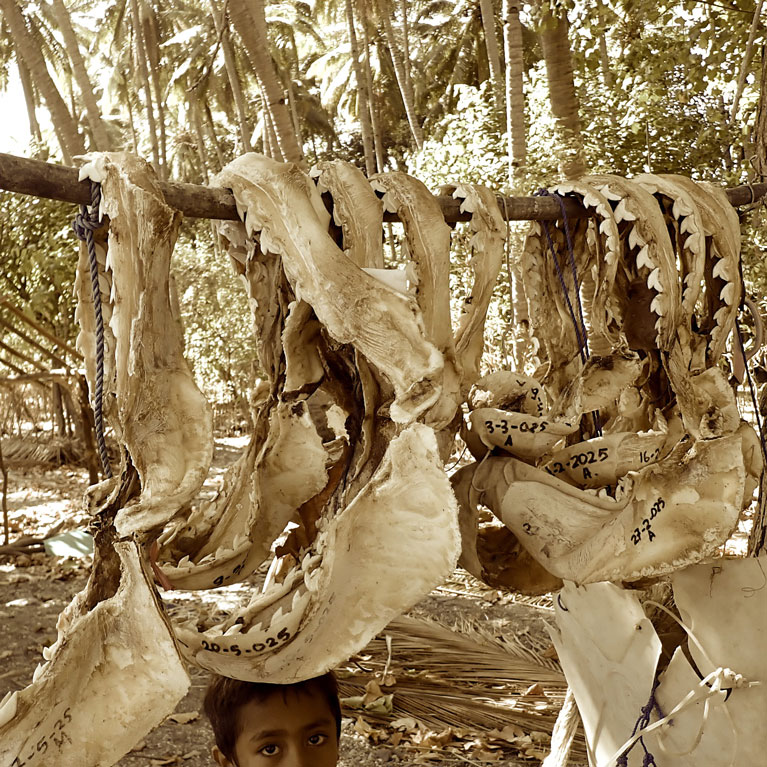Cataloguing shark life in Timor-Leste’s rich waters
Timor-Leste sits in the biodiverse Coral Triangle, a hotspot that spans 5.7 million square kilometres (2.2 million square miles) across Indonesia, Malaysia, Papua New Guinea, the Philippines, the Solomon Islands, Fiji and northern Australia. The region hosts 75% of the world’s coral species, more than 3,000 fish species and six of the seven marine turtles. But although we know whale sharks migrate through these waters, Adriana is one of the first to be documenting the diversity and occurrence of sharks, rays and chimaeras in Timor-Leste’s almost totally undocumented waters. She is working with local communities to identify critical habitats for breeding, feeding and aggregating and to promote shark conservation.
I grew up in Lima, Peru’s capital and largest city, and spent my school holidays at a beach town called Totoritas, where I nurtured a fascination for the ocean. Those play-filled summers in a rocky bay were a refuge from the chaotic city, and the transcendental moments I experienced in nature, charged with freedom and curiosity, were the roots of the love and respect for life that came to determine my purpose. I belong to the first cohort of marine biologists in Peruvian history. During a three-month internship in the Galápagos Marine Reserve, I embarked on a life-long...
Defining critical shark and ray habitat in Timor-Leste
Our aim is to create a baseline for sharks and rays in Timor-Leste by understanding their diversity and ecology and the threats to them, and by engaging with the local community to promote conservation initiatives.
Timor-Leste’s waters are extremely rich in marine species and boast the highest diversity of sharks and rays. Some of the most endangered groups of cartilaginous fishes, such as rhino rays and hammerhead sharks, are expected to inhabit these waters. The limited information about sharks and rays in this recently independent country impedes the management and conservation of this highly endangered group.
Asia is one of the richest regions for marine biodiversity and is home to about 31% of the world’s shark and ray species. Overall, 50% of these species recorded in Asia’s waters are threatened with extinction. Global hotspots for shark mortality are concentrated in coastal habitats, which include the territorial waters of Indonesia, Malaysia, Papua New Guinea and the Philippines; Indonesia reports the highest landings in the world. Population declines are occurring everywhere, but are particularly prevalent in the Indo-Pacific Biodiversity Triangle. Species are disproportionately threatened in tropical and subtropical coastal waters, which makes Timor-Leste, which lies in this region, a priority for the conservation of sharks and rays.
In 2024, the Important Shark and Ray Areas (ISRA) project, led by the IUCN’s Shark Specialist Group, identified 122 critical habitats for cartilaginous fish in Asia. Timor-Leste was one of the few countries in the region with no regional experts and where no ISRAs were identified. Since information about sharks, rays and chimaeras is limited in Timor-Leste, it has been highlighted that research needs to be done on the country’s cartilaginous fish and that fundamental aspects – the species that occur and their key habitats, as well as the uses of these species and their value to local fishers – need to be prioritised. Once more is known about these aspects, it will be possible to develop more specific research, management and conservation initiatives.
- To consolidate a catalogue of the shark, ray and chimaera species present in Timor-Leste’s waters.
- To identify areas with potential to apply the ISRA criteria. For this we will map the current understanding, including local geographic range, habitat occupancy and life-history activities.
- To implement a citizen science project with the aim of developing a baseline for sharks, rays and chimaeras in Timor-Leste that encompasses biodiversity and critical habitats, and engaging with the local community to promote conservation initiatives.


